tire pressure TOYOTA PRIUS C 2016 NHP10 / 1.G Quick Reference Guide
[x] Cancel search | Manufacturer: TOYOTA, Model Year: 2016, Model line: PRIUS C, Model: TOYOTA PRIUS C 2016 NHP10 / 1.GPages: 48, PDF Size: 1.49 MB
Page 3 of 48
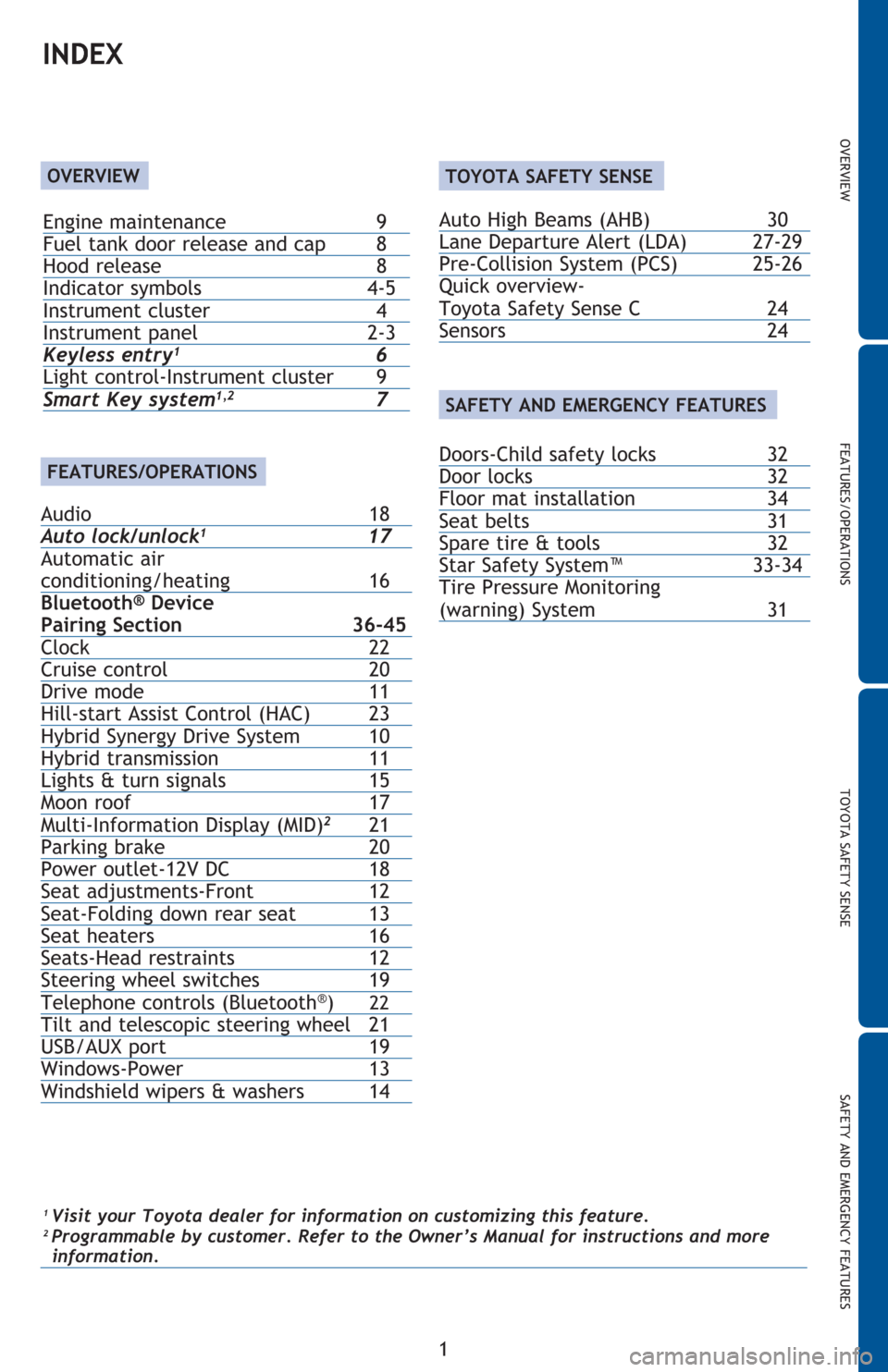
OVERVIEW FEATURES/OPERATIONS TOYOTA SAFETY SENSE SAFETY AND EMERGENCY FEATURES
1
INDEX
1 Visit your Toyota dealer for information on customizing this feature.2 Programmable by customer. Refer to the Owner’s Manual for instructions and more
information.
INDEX
Engine maintenance 9
Fuel tank door release and cap 8
Hood release 8
Indicator symbols 4-5
Instrument cluster 4
Instrument panel 2-3
Keyless entry
1 6
Light control-Instrument cluster 9
Smart Key system
1,2 7
OVERVIEW
FEATURES/OPERATIONS
TOYOTA SAFETY SENSE
Audio 18
Auto lock/unlock1 17
Automatic air
conditioning/heating 16
Bluetooth
® Device
Pairing Section 36-45
Clock 22
Cruise control 20
Drive mode 11
Hill-start Assist Control (HAC) 23
Hybrid Synergy Drive System 10
Hybrid transmission 11
Lights & turn signals 15
Moon roof 17
Multi-Information Display (MID)
2 21
Parking brake 20
Power outlet-12V DC 18
Seat adjustments-Front 12
Seat-Folding down rear seat 13
Seat heaters 16
Seats-Head restraints 12
Steering wheel switches 19
Telephone controls (Bluetooth
®) 22Tilt and telescopic steering wheel 21
USB/AUX port 19
Windows-Power 13
Windshield wipers & washers 14
Auto High Beams (AHB) 30
Lane Departure Alert (LDA) 27-29
Pre-Collision System (PCS) 25-26
Quick overview-
Toyota Safety Sense C 24
Sensors 24
Doors-Child safety locks 32
Door locks 32
Floor mat installation 34
Seat belts 31
Spare tire & tools 32
Star Safety System™ 33-34
Tire Pressure Monitoring
(warning) System 31
SAFETY AND EMERGENCY FEATURES
Page 5 of 48
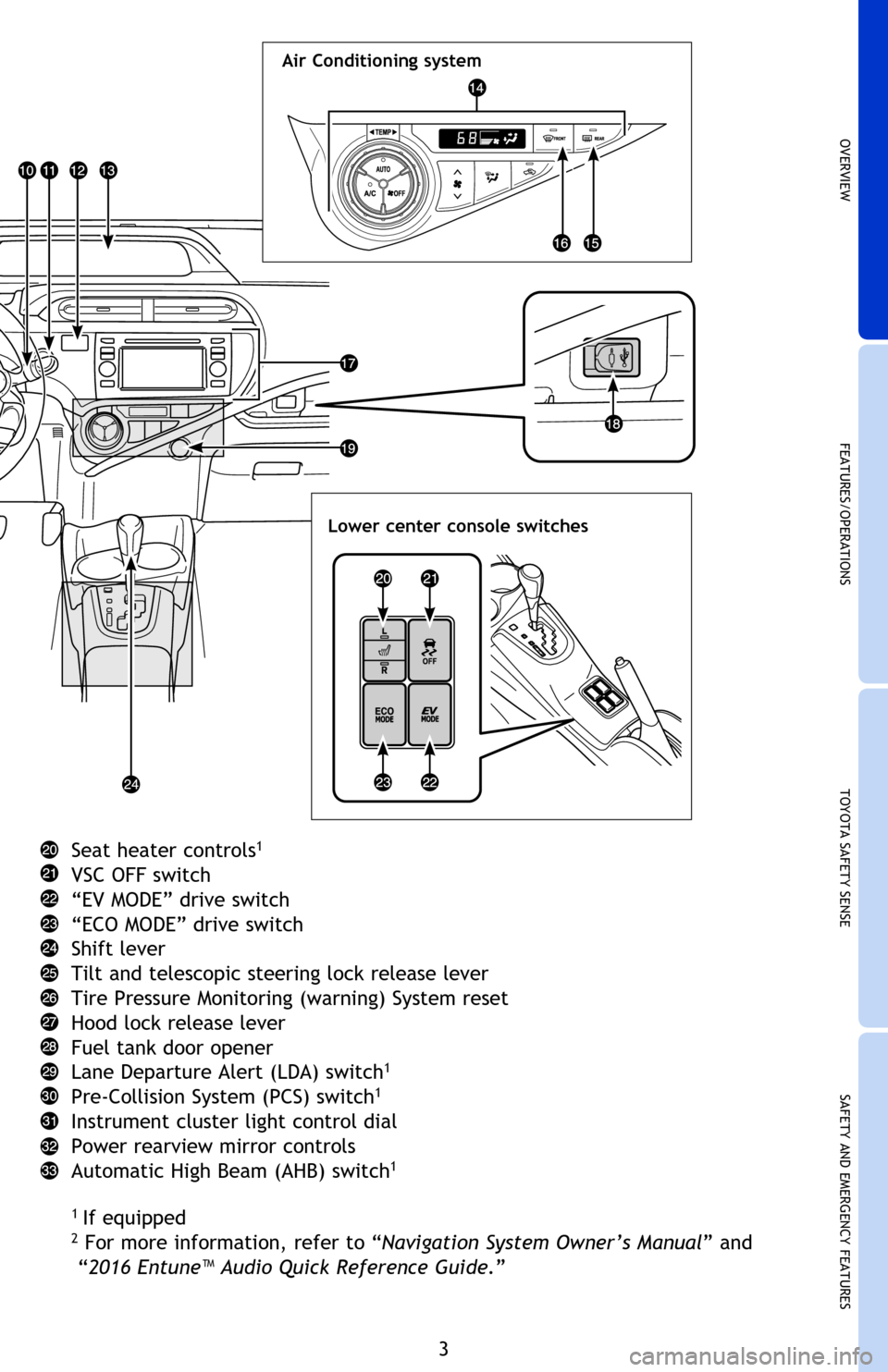
Seat heater controls1
VSC OFF switch
“EV MODE” drive switch
“ECO MODE” drive switch
Shift lever
Tilt and telescopic steering lock release lever
Tire Pressure Monitoring (warning) System reset
Hood lock release lever
Fuel tank door opener
Lane Departure Alert (LDA) switch
1
Pre-Collision System (PCS) switch1
Instrument cluster light control dial
Power rearview mirror controls
Automatic High Beam (AHB) switch
1
1
If equipped2 For more information, refer to “Navigation System Owner’s Manual ” and
“2016 Entune™ Audio Quick Reference Guide.”
OVERVIEW FEATURES/OPERATIONS TOYOTA SAFETY SENSESAFETY AND EMERGENCY FEATURES
3
Air Conditioning system
Lower center console switches
2016_Prius_c_QRG_D2_1.indd 311/13/15 11:19 PM
Page 6 of 48
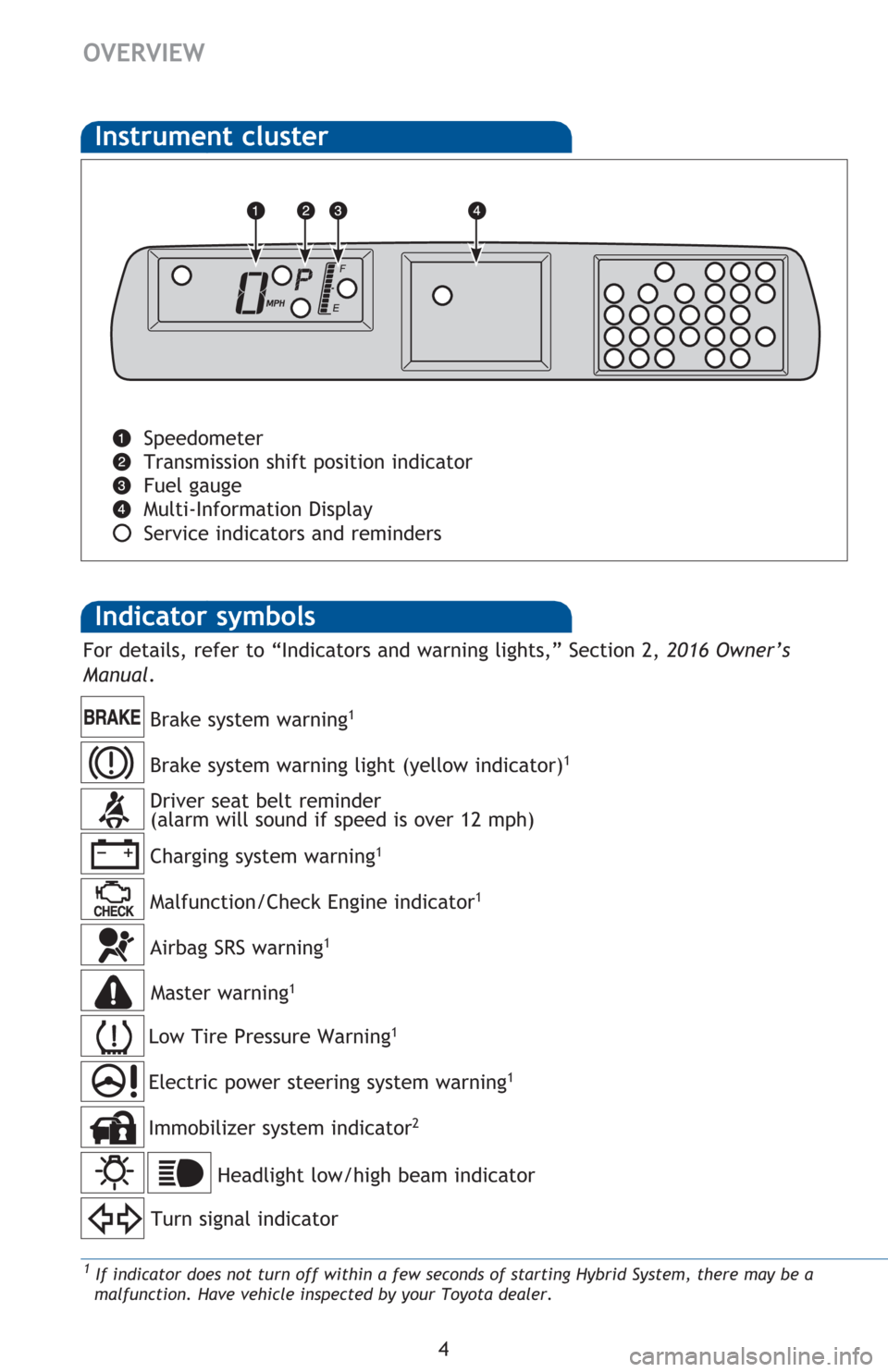
4
OVERVIEW
Indicator symbols
Instrument cluster
Speedometer
Transmission shift position indicator
Fuel gauge
Multi-Information Display
Service indicators and reminders
Charging system warning1
Brake system warning1
Headlight low/high beam indicator
Turn signal indicator
Low Tire Pressure Warning1
Immobilizer system indicator2
Airbag SRS warning1
Master warning1
Malfunction/Check Engine indicator1
Electric power steering system warning1
Driver seat belt reminder
(alarm will sound if speed is over 12 mph)
Brake system warning light (yellow indicator)1
1
If indicator does not turn off within a few seconds of starting Hybrid System, there may be a
malfunction. Have vehicle inspected by your Toyota dealer.
For details, refer to “Indicators and warning lights,” Section 2, 2016 Owner’s
Manual.
Page 12 of 48
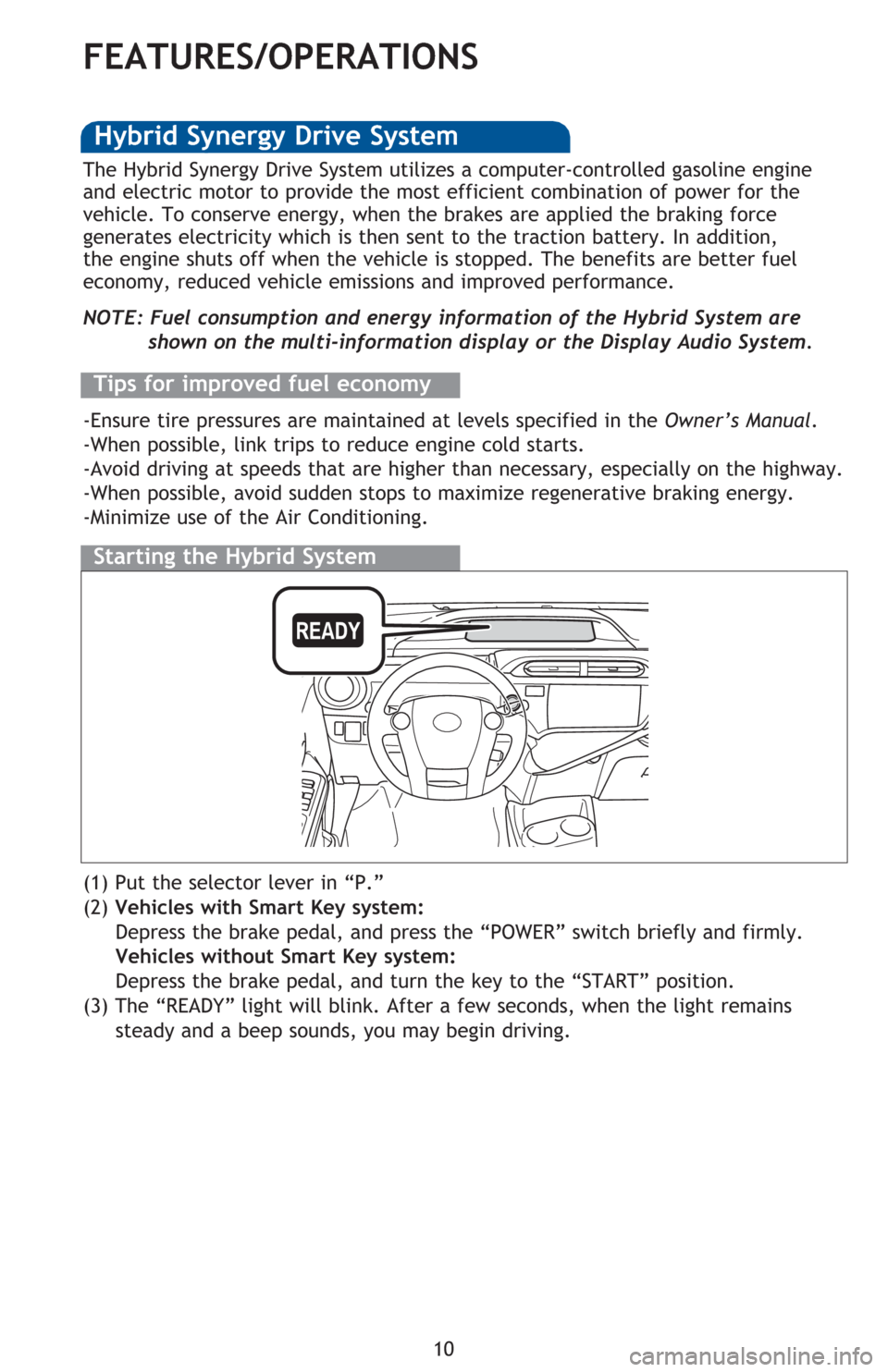
10
FEATURES/OPERATIONS
Starting the Hybrid System
The Hybrid Synergy Drive System utilizes a computer-controlled gasoline engine
and electric motor to provide the most efficient combination of power for the
vehicle. To conserve energy, when the brakes are applied the braking force
generates electricity which is then sent to the traction battery. In addition,
the engine shuts off when the vehicle is stopped. The benefits are better fuel
economy, reduced vehicle emissions and improved performance.
NOTE: Fuel consumption and energy information of the Hybrid System are
shown on the multi-information display or the Display Audio System.
Tips for improved fuel economy
-Ensure tire pressures are maintained at levels specified in the Owner’s Manual.
-When possible, link trips to reduce engine cold starts.
-Avoid driving at speeds that are higher than necessary, especially on the highway.
-When possible, avoid sudden stops to maximize regenerative braking energy.
-Minimize use of the Air Conditioning.
Hybrid Synergy Drive System
(1) Put the selector lever in “P.”
(2) Vehicles with Smart Key system:
Depress the brake pedal, and press the “POWER” switch briefly and firmly.
Vehicles without Smart Key system:
Depress the brake pedal, and turn the key to the “START” position.
(3) The “READY” light will blink. After a few seconds, when the light remains
steady and a beep sounds, you may begin driving.
Page 33 of 48
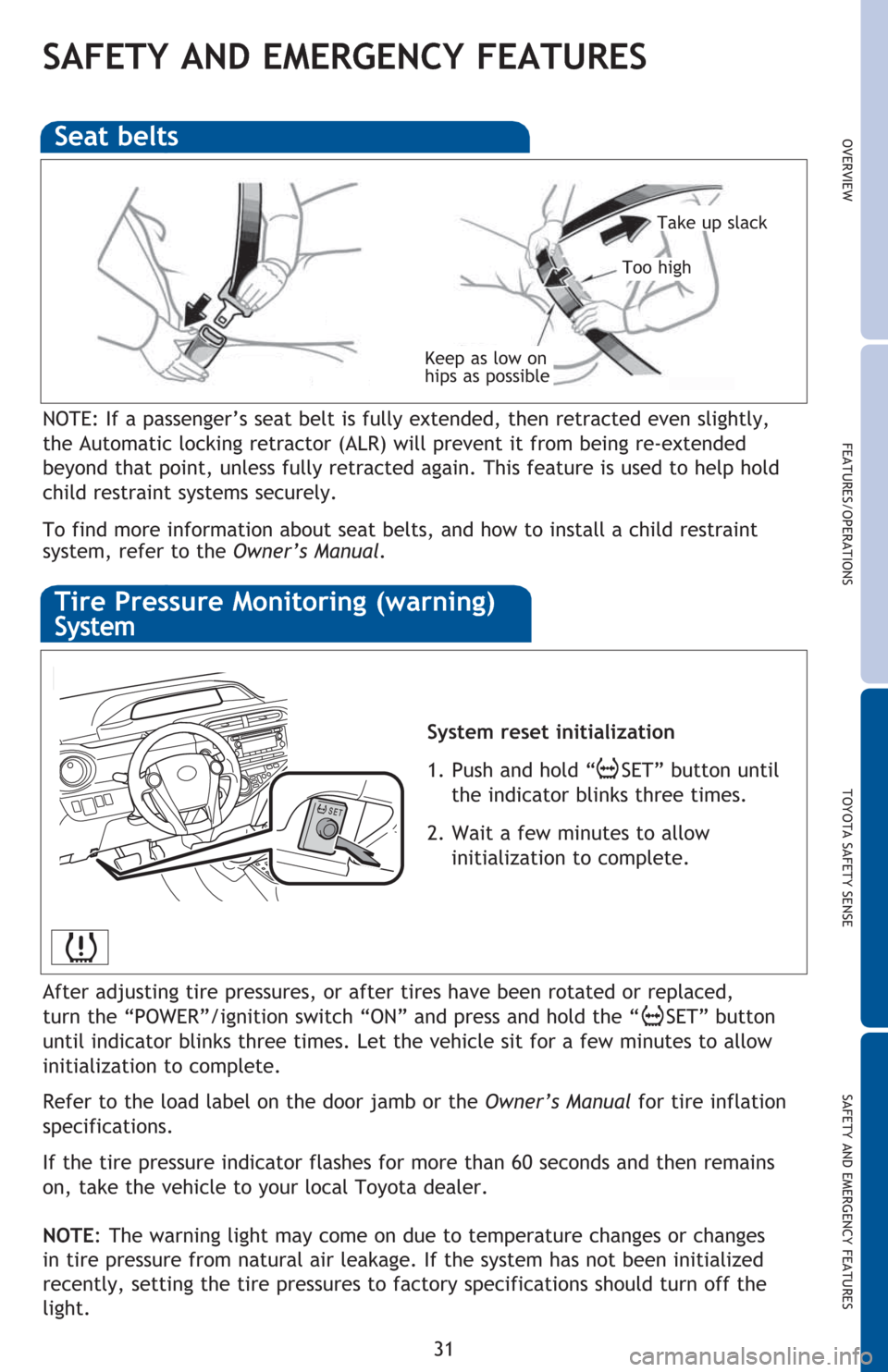
31
OVERVIEW FEATURES/OPERATIONS TOYOTA SAFETY SENSE SAFETY AND EMERGENCY FEATURES
SAFETY AND EMERGENCY FEATURES
Keep as low on
hips as possible
Take up slack
Too high
Seat belts
Tire Pressure Monitoring (warning)
System
STEP4
System reset initialization
1. Push and hold “
SET” button until
the indicator blinks three times.
2. Wait a few minutes to allow
initialization to complete.
After adjusting tire pressures, or after tires have been rotated or replaced,
turn the “POWER”/ignition switch “ON” and press and hold the “
SET” button
until indicator blinks three times. Let the vehicle sit for a few minutes to allow
initialization to complete.
Refer to the load label on the door jamb or the Owner’s Manual for tire inflation
specifications.
If the tire pressure indicator flashes for more than 60 seconds and then remains
on, take the vehicle to your local Toyota dealer.
NOTE: The warning light may come on due to temperature changes or changes
in tire pressure from natural air leakage. If the system has not been initialized
recently, setting the tire pressures to factory specifications should turn off the
light. NOTE: If a passenger’s seat belt is fully extended, then retracted even slightly,
the Automatic locking retractor (ALR) will prevent it from being re-extended
beyond that point, unless fully retracted again. This feature is used to help hold
child restraint systems securely.
To find more information about seat belts, and how to install a child restraint
system, refer to the Owner’s Manual.
Page 35 of 48

OVERVIEW FEATURES/OPERATIONS TOYOTA SAFETY SENSE SAFETY AND EMERGENCY FEATURES
33
Star Safety SystemTM
VSC helps prevent loss of traction during cornering by reducing Hybrid System
output and applying brake force to selected wheels.
Toyota’s VSC monitors steering angle and the direction your vehicle is traveling.
When it senses that the front or rear wheels begin to lose traction, VSC reduces
Hybrid System output and applies braking to selected wheels. This helps restore
traction and vehicle control.
Vehicle Stability Control (VSC)
Anti-Lock Brake System (ABS)
ABS helps prevent brakes from locking up by “pulsing” brake pressure to each
wheel. This limits brake lockup and helps provide directional control for the
current road conditions.
Toyota’s ABS sensors detect which wheels are locking up and limits wheel lockup
by “pulsing” each wheel’s brakes independently. Pulsing releases brake pressure
repeatedly for fractions of a second. This helps the tires attain the traction that
current road conditions will allow, helping you to stay in directional control.
Brake Assist (BA)
Brake Assist is designed to detect sudden or “panic” braking, and then add braking
pressure to help decrease the vehicle’s stopping distance. When there’s only a
split second to react, Brake Assist can add additional brake pressure more quickly
than just the driver alone can. VSC helps prevent loss of traction during cornering by reducing Hybrid System
output, and Traction Control helps maintain traction on loose gravel and wet, icy,
or uneven surfaces by applying brake force to the spinning wheel(s).
Toyota’s TRAC sensors are activated when one of the drive wheels starts to slip.
TRAC limits Hybrid System output and applies the brakes to the spinning wheel.
This transfers power to the wheels that still have traction to help keep you on
track.
Traction Control (TRAC)
Electronic Brake Force Distribution (EBD)
Toyota’s ABS technology has Electronic Brake-force Distribution (EBD) to help
maintain control and balance when braking. Abrupt stops can cause a vehicle
to tilt forward, reducing the braking power of the rear wheels. EBD responds to
sudden stops by redistributing brake force to enhance the braking effectiveness of
all four wheels. All new Toyota vehicles come standard with the Star Safety System
TM, which
combines Vehicle Stability Control (VSC), Traction Control (TRAC), Anti-lock
Braking System (ABS), Electronic Brake-force Distribution (EBD), Brake Assist (BA)
and Smart Stop Technology (SST).